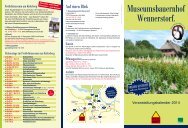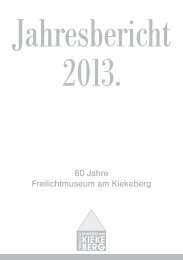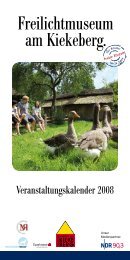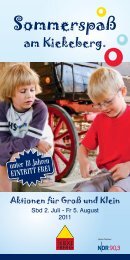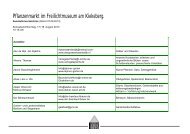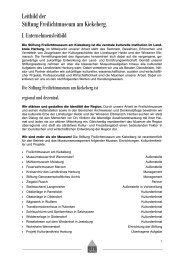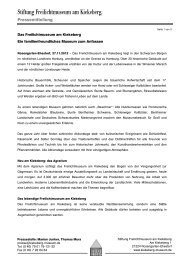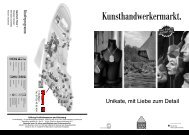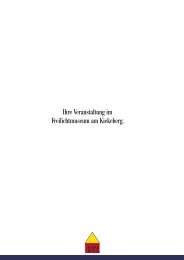Freilichtmuseum am Kiekeberg.
Freilichtmuseum am Kiekeberg.
Freilichtmuseum am Kiekeberg.
Create successful ePaper yourself
Turn your PDF publications into a flip-book with our unique Google optimized e-Paper software.
Farm Shop: [39]<br />
Fruits and vegetables from our organic farm in Wennerstorf<br />
and other museum products such as bread, cake<br />
and sausages are sold in the entrance building .<br />
Telephone: (0 40) 79 01 76-25<br />
Museum Shop: [7]<br />
In our museum, you can find a great variety of unusual<br />
gifts, specialities, treasures from former times and<br />
home-made delicacies! The Museum Shop is one of the<br />
best shopping addresses in North Germany.<br />
Telephone: (0 40) 79 01 76-21<br />
Restaurant: [37]<br />
The Museum Restaurant invites individual guests,<br />
groups, f<strong>am</strong>ilies and company celebrations to enjoy the<br />
regional cuisine – even outside of the museum opening<br />
hours!<br />
Telephone: (0 40) 79 14 44 98<br />
Demonstration Bakehouse: [7]<br />
At the Demonstration Bakehouse you can buy bread<br />
and cakes the way they used to be made in former<br />
days. Our Bioland bakery only uses organic ingredients.<br />
Telephone: (0 40) 79 01 76-81<br />
At a glance<br />
The Stiftung (Trust)<br />
<strong>Freilichtmuseum</strong> <strong>am</strong> <strong>Kiekeberg</strong><br />
Am <strong>Kiekeberg</strong> 1<br />
21224 Rosengarten-Ehestorf<br />
Tel. (0 40) 79 01 76-0 (General information and<br />
bookings)<br />
Tel. (0 40) 79 01 76-40 (Administration)<br />
Tel. (0 40) 79 01 76-25 (Ticket Office)<br />
Fax (0 40) 7 92 64 64<br />
info@kiekeberg-museum.de<br />
www.kiekeberg-museum.de<br />
Opening hours (all year round):<br />
Tue-Sun 10.00<strong>am</strong>—18.00 pm<br />
Also open on Easter Monday and Whit Monday.<br />
Closed on 24th and 25th December and New Year’s<br />
Day.<br />
Society of Friends<br />
Helpline for members on (0 40) 79 01 76-40 or<br />
verein@kiekeberg-museum.de<br />
The agricultural Explore-Garden (“Landwirtschaftlicher Entdeckergarten”)<br />
informs visitors about livestock raising, the<br />
cultivation of the land and historic fruits and invites them to<br />
self-experience activities already before entering the museum.<br />
At the peak of the tourist season, visitors can park<br />
their cars on the field next to the museum.<br />
Ballroom: [33]<br />
You can rent our historic ballroom (built in 1889) for f<strong>am</strong>ily or<br />
business events and festivities.<br />
Telephone: (0 40) 79 01 76-77<br />
Distillery: [33]<br />
The old distillery from Salzhausen has been producing the<br />
traditional “Korn” schnapps from the Heath, the Haidmärker,<br />
since 2006. Are you interested in a guided tour in the<br />
distillery?<br />
Telephone: (0 40) 79 01 76-0<br />
www.museumsbrennerei.de<br />
Visitors’ Service:<br />
We organise guided tours and events for school classes,<br />
children’s birthday parties or for company outings.<br />
Telephone: (0 40) 79 01 76-0<br />
The <strong>Freilichtmuseum</strong> <strong>am</strong> <strong>Kiekeberg</strong> has twelve branch offices<br />
and other facilities under its supervision in which we receive<br />
attractive local cultural items from the region and which we<br />
run as museums. You can find more de details on:<br />
Telepfone: (0 40) 79 01 76-0<br />
www.kiekeberg-museum.de<br />
How to find us<br />
The open-air museum is located nearby H<strong>am</strong>burg in the<br />
idyllic area of Rosengarten. It is only a five minutes’ drive<br />
from the motorway.<br />
A7: Exit H<strong>am</strong>burg-Marmstorf, A261: Exit Marmstorf-<br />
Lürade, from there follow the signs. Free parking.<br />
(When approaching with a navigation system, please<br />
enter the full address).<br />
HVV bus routes: 244 (from Harburg Bus Station) and<br />
340 (from Harburg Bus Station, Neuwiedenthal or<br />
Neugraben).<br />
Englisch 05/12<br />
<strong>Freilichtmuseum</strong> <strong>am</strong><br />
<strong>Kiekeberg</strong>.<br />
We would like to invite you to a short journey trough<br />
time through the cultural history of the Winsener<br />
Elbmarsch and the Lüneburg Heath. Important sources<br />
of this history are the farmhouses with their outbuildings.<br />
For instance, the Silberhof which was brought here from<br />
Scharmbeck (region in Lower Saxony) (built in 1612), is<br />
one of the most splendid farmhouses of Lower Saxony<br />
in our museum.<br />
Next to the buildings you will find beautiful gardens and<br />
Our exhibition building<br />
Open Air Museum<br />
Have fun on your tour through the museum.<br />
I<br />
III<br />
IV<br />
V<br />
domestic animals (horses, cows, pigs, sheep, hens and<br />
geese) that are typical of that period.<br />
Apart from our farmhouses that turn our museum into<br />
an interesting attraction, there is a set of buildings,<br />
which catches the visitor’s eye, as it demonstrates the<br />
development of the rural region from the present day to<br />
the time around 1600. This development is divided into<br />
five categories:<br />
MECHANISATION OF THE FARMS<br />
INDUSTRIAL TIMES IN THE VILLAGE<br />
HEATH VILLAGE<br />
MARSH VILLAGE<br />
To find your way, please follow the signs for the tour through our museum.<br />
Apart from our outdoor exhibits, you can find other<br />
exhibitions about other regional topics on an area of<br />
approx. 2000 sq. m. in our exhibition building .<br />
The permanent exhibition „Rural life in the ‘50s“ gives<br />
an insight into the regional development from 1945 to<br />
1965. These miracle years in which many<br />
refugees found a new home and began to build up a<br />
new livelihood, made a lasting impression on the<br />
II<br />
POSTWAR PERIOD<br />
Federal Republic of Germany. In our exhibition<br />
building you will also find special exhibitions.<br />
The historic demonstration bakehouse is also located<br />
in our exhibition building and produces fresh bread<br />
every day – of course in organic quality – as well as<br />
biscuits and cakes.<br />
Nearby there is the Museum Shop that offers a wide<br />
range of traditional products.
Activity trail through the museum:<br />
At various points throughout the terrain of the<br />
museum, you and your children can try yourselves<br />
at historic crafts and other work.<br />
On our water-adventure-trail you can<br />
discover the rural water supply of former times.<br />
Everybody is welcome to play and experiment.<br />
1. Agrarium<br />
Would you like to see a special and interactive<br />
exhibition? – Visit the Agrarium!<br />
The “Agrarium” focuses on the topics agriculture<br />
and food industries and offers children<br />
and adults the opportunity to learn everything<br />
of interest about the sources of food of former<br />
times, the present day and the future.<br />
I. MECHANISATION OF THE FARMS<br />
Mechanisation was introduced to the<br />
country in the 1850s.<br />
2. Göpel shed from Groß Todtshorn<br />
(built around 1880/90)<br />
A “Göpel” was a gear unit that redirected the<br />
power of an animal to a machine. It was used to<br />
drive threshing machines, chaffing machines<br />
etc. before the introduction of internal combustion<br />
engines.<br />
3. Potato storehouse from Otter<br />
(built 1887)<br />
During the 19th and 20th centuries potatoes<br />
bec<strong>am</strong>e the most important crop of the heath.<br />
They could be stored during winter in the frostprotected<br />
cellar of the storehouse. The halftimbered<br />
storehouse was moved to the<br />
museum as one unit. It was also used for<br />
storing grain.<br />
4. Hen-house from Winsen<br />
(built around 1910)<br />
The replica of a hen-house, which was made of<br />
r<strong>am</strong>med clay, was built in a simple method<br />
such as it used to be established in difficult<br />
times, e.g. after the World Wars.<br />
5. Wind wheel from Asendorf<br />
(built around 1900)<br />
The wind wheel was used to supply water.<br />
Generators were driven by such wind wheels<br />
for providing energy. .<br />
6. R<strong>am</strong> system<br />
(built in the 1910s, reconstruction)<br />
Pumping stations, as this one, were solely<br />
driven with water pressure of a spring and were<br />
used to supply villages with water.<br />
II. POSTWAR PERIOD<br />
The 1950s were a decade of changes and<br />
industrial growth and is commonly known as<br />
the “economic miracle”. However, many people<br />
still lived in emergency accommodations due to<br />
poverty.<br />
7. Exhibition building<br />
In the exhibition building you can find a reconstruction<br />
of a modern farm of the1950s as<br />
well as an exhibition that shows what caught<br />
the children’s eye in the post-war period.<br />
Furthermore, you will also find special exhibitions<br />
of the Museum Shop and the Demonstration<br />
Bakehouse.<br />
8. Nissen hut<br />
Nissen huts are emergency accommodations<br />
that were provided by the British military from<br />
autumn 1945 onwards for refugees and<br />
bombed-out victims.<br />
II. INDUSTRIAL TIMES IN THE VILLAGE<br />
Around the1850s , the development of rural<br />
industries in the villages began. These included,<br />
for instance, dairies and brickworks and, with<br />
the introduction of cement, also concrete prefabricated<br />
parts.<br />
9. Rural brickworks<br />
(built 1850, reconstruction)<br />
Since the 16 th century there is evidence of rural<br />
brickworks. (see House 18, Silberhof). As a<br />
result of the building boom towards the end of<br />
the 19th century, a large number of smaller farm<br />
brickworks were constructed. For instance, the<br />
farm brickworck, which you can visit here, was<br />
reconstructed according to plans of a brickwork<br />
from 1850. The works include a “German firing<br />
stove”, a brick-drying shed and a horse drawn<br />
pug mill used for preparing the clay.<br />
10. Prefabricated concrete parts works<br />
(built around 1900, reconstruction)<br />
In the turn of the century, various rural works for<br />
prefabricated concrete parts arose in the region.<br />
The reconstructed works from Oelstorf belonged<br />
to the Harms Distillery (House 33)<br />
III. HEATH VILLAGE<br />
Typical of the rural economy of the Northern-<br />
Heath was the keeping of animals as the<br />
grounds were not very fertile and just suitable<br />
for the growth of some field crops. That is why<br />
all kinds of animals that could be found on a<br />
40<br />
farm around 1900 are kept at the <strong>Freilichtmuseum</strong><br />
<strong>am</strong> <strong>Kiekeberg</strong>. They are mainly domestic<br />
breeds that are threatened with extinction such<br />
as the pigs “Bunte Bentheimer”, the cattle “<br />
Schwarzbuntes Niederungsvieh” and the hens<br />
“R<strong>am</strong>elsloher Blaubeine“.<br />
11. Cart shed from Wistedt<br />
(built around 1880)<br />
In the middle of the 19 th century, the country<br />
folk began to build more cart sheds. The<br />
reason was, <strong>am</strong>ong other things, increasing<br />
harvest yields.<br />
12. Smithy from Pattensen<br />
(built around 1800)<br />
We show the village smithy with its original<br />
interior and tools with which the old craft is still<br />
demonstrated today. This building was moved<br />
to the museum in large wall partitions.<br />
13. Corbelinscher Hof from Pattensen<br />
(built in 1687)<br />
The farmhouse is occupied today by the<br />
caretaker’s f<strong>am</strong>ily.<br />
41<br />
14. Apiary from Ehestorf<br />
(built in 1850/70)<br />
Apart from keeping German heaths (a small<br />
primitive breed of horned sheep typical of the<br />
Lüneburg Heath), beekeeping was an important<br />
source of income for many farmers living in the<br />
Heath.<br />
15. Dragonerscheune (Dragoons’ Barn) from<br />
Asendorf (built around 1770/80)<br />
The building was used as storeroom for the fuel<br />
peat and as a farm workshop (locally known as<br />
a “Klöterk<strong>am</strong>mer”). The farm shop was used for<br />
the production of field carts etc. (cartwright) and<br />
as billeting room for a Hannovarian dragoon.<br />
16. “Häuslingshaus” from Emsen<br />
(built around 1800) with bakehouse<br />
Day labourers occupied a farm house as temporary<br />
workers for the farmer. The day labourers<br />
(Häuslinge) kept their own cattle and very often<br />
produced pan-scrubbers made of heather,<br />
baskets or clogs on the side.<br />
17. Enclosures in the Open Air Museum<br />
Before barbed wire was introduced in 1900,<br />
children used to tend the cattle. In order to<br />
protect the farmyard, walls, oak fences and<br />
plaited fences were established.<br />
18. Silberhof from Scharmbeck<br />
(built in 1612)<br />
One of the most splendid farmhouses in Lower<br />
Saxony was built master brickmaker Peter<br />
Lemke of Scharmbeck. It shows the interior<br />
around 1600.<br />
42<br />
19. Storage shed from Ochtmannsbruch<br />
(built around 1750)<br />
The farms in the Heath had various outbuildings,<br />
including storage sheds in which<br />
precious objects were stored because of<br />
the danger of fire in the farmhouse.<br />
20. Pfarrscheune (Parochial Barn) from<br />
Sinstorf<br />
(built around 1850/60)<br />
The building was firstly used as a bakehouse<br />
and later converted into a parochial barn where<br />
young people were taught in preparation for<br />
their confirmation. In the museum it is used as<br />
a guest house.<br />
21. Honigspeicher (beekeeper’s store) from<br />
Riepshof near Otter (built in 1688)<br />
The beekeeper’s store was used for storing all<br />
the equipment for the farm beekeeper and<br />
belonged to the farm estate around the Pringen<br />
Hof.<br />
22. Garden by the Pringen Hof<br />
The farmhouse garden is arranged in the style<br />
of around 1900 with boxwood hedges in a<br />
geometric pattern.<br />
1<br />
43<br />
23. Pringen Hof from Kakenstorf<br />
(built in 1797)<br />
Built as the farmhouse of a smallholder (small<br />
farmer). The typical heath farm house is furnished<br />
as it was around 1800.<br />
24. Linen store from Garlstorf<br />
(built in 1750)<br />
It was used as storeroom for food and linen<br />
and for accommodating a day labourer<br />
“Häusling” or the weaving loom that was dismantled<br />
during the summer months.<br />
25. Cart sheds<br />
(around 1850/70, reconstruction)<br />
In these sheds the field carts were stored.<br />
26. Drive through barn from Riepshof near<br />
Otter (built in 1688)<br />
It was probably built as the farm sheepfold, but<br />
later used as a barn with adjoining pig sty.<br />
27. Tithe barn from Kakenstorf<br />
(built in 1602)<br />
In the barn the natural produce was stored,<br />
which was paid as tithe in kind by the farmers<br />
to their masters .<br />
28. Bakehouse from Riepshof near Otter<br />
(built in 1688)<br />
In former days, every four weeks bread was<br />
baked for the whole farm. At the museum,<br />
there are regular baking demonstrations<br />
throughout the summer<br />
(every Thursday morning).<br />
7<br />
6<br />
3<br />
8<br />
4<br />
9<br />
10<br />
36<br />
38<br />
29. Sheepfold from Wesel<br />
(built around approx. 1600)<br />
The sheepfold was used as an outdoor<br />
sheepfold into which the sheep were brought<br />
in the evenings.<br />
IV. MARSH VILLAGE<br />
The fertile region of the Winsener Marsch is<br />
situated along the Elbe. On the high-yielding<br />
ground cattle were kept, horses bred, agriculture<br />
and vegetable growing carried out. Many<br />
f<strong>am</strong>ilies from the Elbe river lived, i.e. from<br />
shipping and small trade.<br />
30. Hof Meyn from Marschacht<br />
(built in 1560)<br />
When it was built, the farm in the Winsener<br />
Marsch was one of the largest farms. The<br />
good soil of the marsh brought wealth<br />
upon the f<strong>am</strong>ilies and allowed the construction<br />
of such impressive buildings. In our<br />
museum the farm is furnished in the condition<br />
of the 1850s.<br />
31. Barn from Tespe<br />
(built in 1586)<br />
The barn was used as a corn storage barn. It<br />
5<br />
2<br />
12<br />
is set up in the museum as “House of Crafts” for<br />
demonstrating old and new crafts.<br />
32. Barns from Handorf<br />
(built in 1665)<br />
The cattle feeding barn, currently under construction,<br />
shows a rare carpentry technique on<br />
the street-side gable.<br />
33. Ballroom with Museum<br />
Distillery from Pattensen (built in 1889)<br />
In the economic boom from 1880 onwards a<br />
great number of rural ballrooms were built. The<br />
Harms Distillery from Salzhausen (today’s<br />
Museum Distillery) is integrated into the ballroom<br />
from Pattensen.<br />
34. Drainage with the Drainage mill<br />
(built 1860, reconstruction)<br />
As large areas of the Winsener Marsch<br />
Are situated below the level of the Elbe, therefore,<br />
the inhabitants had to drain the land with<br />
the help of portable wind mills until 1890. The<br />
continual necessary drainage and dyke maintenance<br />
measures involved great effort and costs.<br />
37<br />
39<br />
13<br />
33<br />
11<br />
31<br />
35<br />
15<br />
28<br />
29<br />
32<br />
22<br />
14<br />
34<br />
16<br />
26<br />
27<br />
30<br />
17<br />
21<br />
20<br />
19<br />
23<br />
25<br />
18<br />
24<br />
35. Craftsmen’s and fishermen’s house from<br />
Drage<br />
(built in 1703)<br />
The owners were craftsmen for many years and<br />
fished on the side. After the Second World War<br />
the house was used as accommodation for<br />
refugees. There was even a hairdressing salon<br />
included for a while.<br />
36. Skittle Alley from Mover<br />
(built in 1880/90)<br />
The skittle alley was built next to a small station<br />
tavern and is an early building of the beginning<br />
rural leisure culture, as tavern and ballroom.<br />
37. Priests’ Widows’ House from Marschacht<br />
(built in 1698) (Museum Restaurant “Stoof Mudders<br />
Kroog”) The Priests’ Widows’ House from<br />
Marschacht was used as home for elderly widows<br />
of priests. In addition, from 1815 onwards it<br />
was used as restaurant or tavern. Today it<br />
houses the museum restaurant “Stoof Mudders<br />
Kroog“ that can also be visited outside of museum<br />
opening hours.<br />
38. Garden Pavillion from Luhdorf<br />
(built around 1902, reconstruction)<br />
The original of the Wilhelminian garden<br />
pavilions was built next to the Pehmüller’s<br />
Restaurant in Luhdorf. Around the turn of the<br />
century there were garden pavilions in many<br />
country restaurant gardens.<br />
39. Wagnersches Haus from Oldershausen<br />
(built in 1803) (entrance building)<br />
The house that was originally a tavern with its<br />
own farm that was located at the river Ilmenau.<br />
It has been rebuilt in the Open Air<br />
Museum and furnished in the style of the<br />
1900s. On the first floor of the former ballroom<br />
there are the museum’s spinning and<br />
the weaving room.<br />
40. Schäfer-Ast-Garden<br />
(garden for the blind people)<br />
Schäfer Ast was a well-known miracle healer<br />
from Radbruch (1848-1921) who helped<br />
many people with folk medicine. In the<br />
museum there is a garden that is set out with<br />
raised beds as a garden for the blind.<br />
41. Lüneburger Landgarten<br />
(Kitchen Garden)<br />
In the Lüneburger Landgarten, a large<br />
number of historical plants from agriculture<br />
and horticulture are cultivated. They are sold<br />
under the brand-n<strong>am</strong>e “Lüneburger Landgarten<br />
- Gutes schmeckt“ (literally: Lüneburg<br />
Kitchen Garden – Good Food Tastes Good)<br />
in the Farm Shop.<br />
The gardens 40 and 41 can be found behind<br />
the exhibition building<br />
42. Water-Playground<br />
The water-playground is part of the wateradventure-trail.<br />
Children and adults discover<br />
the element water.<br />
43. „Milchpilz“-snack bar<br />
Our "Milchpilz"-snack bar is open in summer<br />
and offers a variety of snacks and refreshments.<br />
Water-adventure-trail<br />
Activity trail<br />
Toilets<br />
Disabled Toilets<br />
Baby room<br />
First aid box<br />
Restaurant<br />
Picnic area<br />
Playground<br />
Museum Shop



